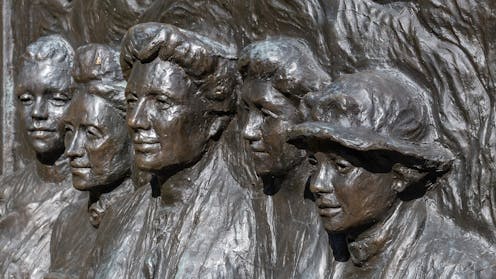an old recipe sheds new light on the feminist pioneer’s life
- Written by Katie Pickles, Professor of History, University of Canterbury

Political and social reformer Kate Sheppard is famous for leading the campaign that saw New Zealand women become first in the world to gain the right to vote on September 19 1893. We don’t normally think of her as a cook.
But while she far preferred reading and writing, she did consider women’s domestic labour as essential. She was also interested in the possibility of communal kitchens and laundries as ways to increase efficiency.
I’m researching and writing a new biography of Sheppard. And it was while building a more complex understanding of her that I discovered a recipe she contributed to a small book titled Everybody’s Cookery Book of Tested Recipes.
But while the Lovell-Smith family were Methodist stalwarts, featured on the church roll, Kate’s involvement in the cookery book suggests she was still a Congregationalist (along with her nieces, whose recipes are also included).
In fact, the cookery book is evidence of Sheppard’s enduring association with Trinity Congregational Church, which she had first attended on arrival in Christchurch from Britain in 1869. And it was within those church walls during the 1870s and 1880s that she came into her own as a colonial feminist.
As was typical for many in the women’s movement at that time, church work served as an apprenticeship and incubator for later political activity. In Sheppard’s case, she was secretary of the Ladies’ Association Committee. She successfully raised funds for the church and was a “lady visitor” – a kind of social worker or lay preacher, helping members of the congregation.
Sheppard also taught Sunday school and a young women’s Bible class, nurturing a generation of “new women”. Writer and feminist Jessie Mackay later recalled Sheppard as “a gracious and beautiful young matron” leading her Bible class. It is in church records that Sheppard’s clear, capable and increasingly confident voice emerges.
A catalyst moment in the history of women’s suffrage occurred on May 14 1885, at Trinity Church, when Sheppard heard American Women’s Christian Temperance Union (WCTU) missionary Mary Clement Leavitt speak at one of her many meetings around New Zealand.
This led to the formation of national WCTU branches and Sheppard becoming head of its franchise department. From then until success in 1893, Kate led the campaign for women’s suffrage, coordinating the largest petition yet assembled in New Zealand.
Spanish cream and Esperanto
So what of the recipe itself? New Zealand food historian Duncan Galletly has studied the complex evolution of the dessert, from its hazy centuries-old European cream origins to its place as a gelatine-set custard. It was by then becoming popular in colonial New Zealand.
Without crediting Sheppard, Galletly captures the recipe in his research, noting it is actually the same as one in the first edition of a 1901 book, Colonial Everyday Cookery. As is often the case with fundraiser cookery books, Sheppard appears to have directly copied it years later.
Sheppard liked a bit of luxury and serving creamy treat foods. A great niece recalled visiting her “lovely home” in the 1920s and
sitting in the luxurious drawing room, having afternoon tea, terrified of dropping a cup or spilling cream cake – Aunt Kate was so elegant, wore lovely gowns and jewellery, and moved about like a queen. She was beautiful.
Sheppard was also interested in vegetarianism and wholefoods, although the presence of gelatine in her recipe reveals she was not a strict vegetarian. Especially interesting was her pursuit of the connection between a healthy mind and healthy body, and what she suspected was a “close connection between meat eating and the craving for alcohol”.
In 1901, she cycled to Sanitarium Health Foods to interview Seventh-day Adventist and American doctor, feminist, prohibitionist and early vegan Dr Florence Keller. Sheppard was impressed that Keller advocated a healthy, plant-based diet rich in whole grains, fruits and vegetables. And she was fascinated with Keller’s opinion that
Flesh is a highly stimulating form of diet, and produces a desire for stimulants of various kinds. A meat diet predisposes to a love of condiments; as well as to the different forms of alcoholic liquor.
Keller also impressed Sheppard with her belief that tobacco was “highly injurious” and in the same class as “alcoholic and morphine habits”.










